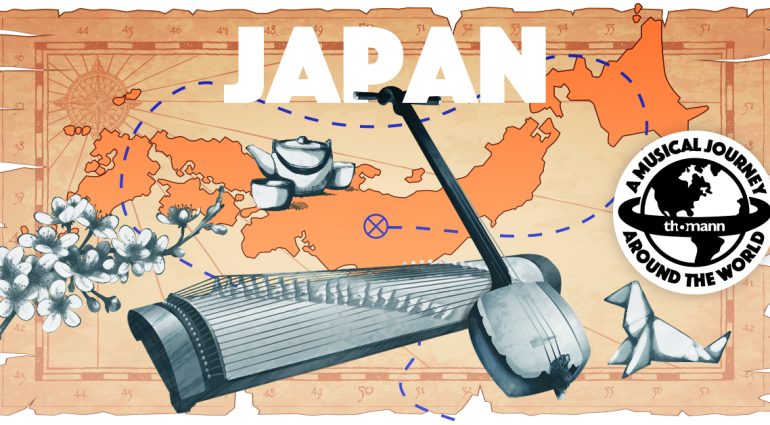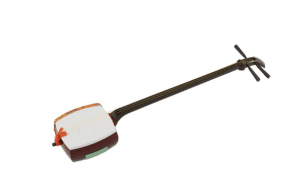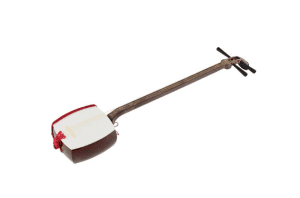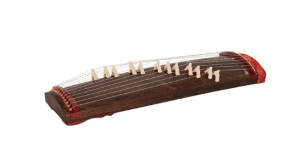
After China, we fly for a few more hours and land in Japan. Here, too, we discover a wide variety of interesting instruments and diverse sounds. Besides unique J-rock bands and viral anime openings, Japan offers a centuries-old tradition of music and art. Japanese music is not only culturally rich, but also deeply rooted in the country’s identity. It is a window into the soul of Japan and an important source of inspiration, today as much as hundreds of years ago. Let’s take a closer look at three of the many traditional Japanese musical instruments.
Shakuhachi
One of the best-known Asian musical instruments with an exciting and dramatic history is the Japanese bamboo flute Shakuhachi. Originally from China, the shakuhachi quickly became an integral part of zen Buddhist meditation music. As the flute could not keep up with the volume of mouth organs and drums in gagaku court music ensembles, it quickly fell out of use there, only to reappear as a spiritual tool for monks. Here, the shakuhachi went through highs and lows – playing it was even forbidden at times.
Here you can find Shakuhachi instruments in our shop.
Nowadays, however, the Shakuhachi once again enjoys great popularity and is even regularly featured as a sample in songs by modern artists. For example, in Linkin Park’s “Nobody’s Listening,” you can hear a shakuhachi playing almost continuously in the background. Take a listen!
You are currently viewing a placeholder content from YouTube. To access the actual content, click the button below. Please note that doing so will share data with third-party providers.
Shamisen
When talking about traditional Japanese music, one instrument that must be mentioned is the shamisen. The three-stringed long-necked lute is used in the traditional stage art of Kabuki but also enjoys great popularity in modern music. Interestingly, the Shamisen has always been played by all social groups, so it was not just reserved for aristocrats or scholars.
Geishas in particular are often seen playing the shamisen for entertainment. At first glance, the instrument looks a bit like a guitar and is held in a similar way. The sound of the shamisen is more reminiscent of a banjo. However, the way it is played differs fundamentally from both: It is played with a large, leaf-shaped “bachi” pick and the fretless fingerboard allows for completely different sonic expressions than those possible on a banjo, for example. Got interested? Start right away with the shamisen models available in our Thomann Shop.
You are currently viewing a placeholder content from YouTube. To access the actual content, click the button below. Please note that doing so will share data with third-party providers.
Koto
One of the best-known and most popular traditional stringed instruments from Japan is the koto. Anyone who feels reminded of the Chinese guzheng at the sight of this long, arched, wooden zither is completely right! The zither came to Japan around the year 700 AD and developed into the koto as we know it today. Originally used in gagaku, the elegant court music of the imperial era, as the gakuso rhythm instrument, the koto still enjoys great popularity in the popular music of the 21st century.
The koto is played similarly to the Guzheng, with artificial nails and various, mostly pentatonic, tunings. The biggest difference is probably the number of strings and the type of picks and strings used, which produce a softer and gentler sound than that of the Guzheng. By the way, the parts of the koto are named after the body parts of a mythological dragon. Can you see the resemblance? Koto instruments can be found under this link in our shop.
Instruments at Thomann
Here’s to the department of world instruments & traditional instruments.
Here’s to the Japanese instruments at Thomann.
For inquiries about world instruments, our colleagues in the specialist department are very happy to advise you, of course, without obligation.
About the author Sophie
Sophie joined the String and World Instruments department at Thomann in 2018. Originally working as a specialist advisor in the field of violins and string instruments, her interest quickly shifted to the diverse ethnic instruments of various countries. Today, her small apartment resembles more of a museum, filled with musical instruments from around the world. Sophie plays the violin, saxophone, bass, guitar, Guzheng, Hulusi, and Ruan, among countless other instruments.

Sophie
You are currently viewing a placeholder content from Facebook. To access the actual content, click the button below. Please note that doing so will share data with third-party providers.
More InformationYou are currently viewing a placeholder content from Instagram. To access the actual content, click the button below. Please note that doing so will share data with third-party providers.
More InformationYou are currently viewing a placeholder content from X. To access the actual content, click the button below. Please note that doing so will share data with third-party providers.
More Information










